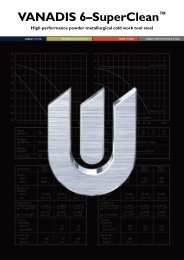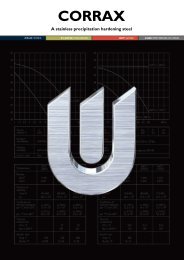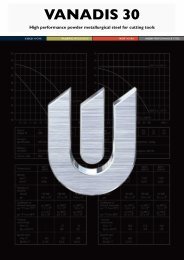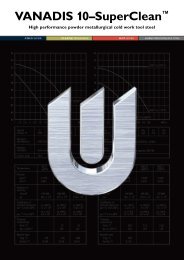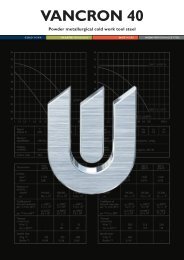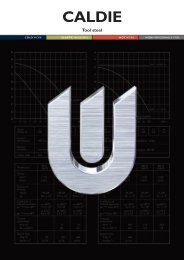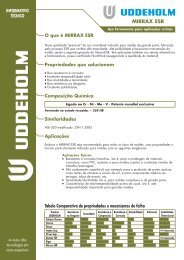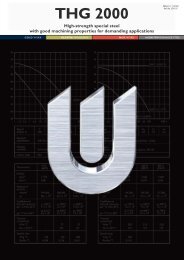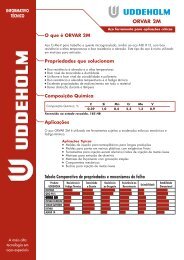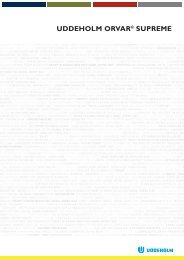<strong>STAVAX</strong> <strong>ESR</strong>PropertiesPHYSICAL DATAHardened and tempered to 50 HRC. Data at roomand elevated temperatures.Temperature 20°C 200°C 400°C(68°F) (390°F) (750°F)Density, kg/m 3 7 800 7 750 7 700lbs/in 3 0,282 0,280 0,277Modulus of elasticityN/mm 2 200 000 190 000 180 000tsi 12 900 12 300 11 600psi 29,0 x 10 6 27,6 x 10 6 26,1 x 10 6Coefficient of thermalexpansion/°C from 20°C – 11,0 x 10 -6 11,4 x 10 -6/°F from 68°F – 6,0 x 10 -6 6,5 x 10 -6Thermalconductivity*W/m °C 16 20 24Btu in/(ft 2 h °F) 110 138 166Specific heatJ/kg °C 460 – –Btu/lb, °F 0,110 – –* Thermal conductivity is very difficult to measure. The scattercan be as high as ±15%.TENSILE STRENGTH AT ROOM TEMPERATUREThe tensile strength values are to be considered asapproximate only. All samples were taken from abar (in the rolling direction) 25 mm (1") diameter.Hardened in oil from 1025 ±10°C (1880 ± 20°F) andtempered twice to the hardness indicated.Hardness 50 HRC 45 HRCTensile strength RmN/mm 2 1 780 1 420kp/mm 2 180 145tsi 114 92psi 256 000 206 000Yield point Rp0,2N/mm 2 1 460 1 280kp/mm 2 150 130tsi 95 83psi 213 000 185 000The influence of tempering temperature on corrosionresistance.Increasing corrosion resistanceCorrosionresistance100 200 300 400 500 600Tempering temperature°CHeat TreatmentSOFT ANNEALINGProtect the steel and heat through to 890°C(1630°F). Then cool in the furnace at 20°C (40°F)per hour to 850°C (1560°F), then at 10°C (20°F) perhour to 700°C (1290°F), then freely in air.STRESS-RELIEVINGAfter rough machining the tool should be heatedthrough to 650°C (1200°F), holding time 2 hours.Cool slowly to 500°C (930°F), then freely in air.HARDENINGPreheating temperature: 600–850°C (1110–1560°F)Austenitizing temperature: 1020–1050°C (1870–1920°F), but usually 1020°C–1030°C (1870–1885°F).Temperature Soaking time* Hardness before°C °F minutes tempering1020 1870 30 56± 2 HRC1050 1920 30 57± 2 HRC* Soaking time = time at hardening temperature after the tool isfully heated through.Protect the part against decarburization andoxidation during hardening.CORROSION RESISTANCE<strong>STAVAX</strong> <strong>ESR</strong> is resistant to corrosive attack bywater, water vapour, weak organic acids, dilutesolutions of nitrates, carbonates and other salts.A tool made from <strong>STAVAX</strong> <strong>ESR</strong> will have goodresistance to rusting and staining due to humidworking and storage conditions and when mouldingcorrosive plastics under normal production conditions.<strong>STAVAX</strong> <strong>ESR</strong> shows the best corrosion resistancewhen tempered at low temperature and polished toa mirror finish.4
<strong>STAVAX</strong> <strong>ESR</strong>QUENCHING MEDIA•Oil• Fluidized bed or salt bath at 250–550°C(480–1020°F), then cool in air blast• Vacuum with sufficient positive pressure• High speed gas/circulating atmosphere.In order to obtain optimum properties, the coolingrate should be as fast as is concomitant withacceptable distortion. When heat treating in avaccuum furnace, a 4–5 bar overpressure is recommended.Temper immediately when the tool reaches50–70°C (120–160°F).Hardness, grain size and retained austenite as afunction of the austenitizing temperature.GrainsizeASTM Hardness HRC10 609 58Holding time60 min.876543215654Retained austenite %4052504846RetainedHolding time austenite44 20 min.4240960 980 1000 1020 1040 1060 1080 °C1760 1795 1830 1870 1905 1940 1975 °FAustenitizing temperatureTEMPERINGChoose the tempering temperature according to thehardness required by reference to the temperinggraph. Temper twice with intermediate cooling toroom temperature. Lowest tempering temperature180°C (360°F) for small simple inserts, but 250°C(480°F) is the preferred minimum. Holding time attemperature minimum 2 hours.Tempering graphHardnessHRC6055504540353025Grain size1020°CRetained austenite1030°C302010Retained austenite %141050°C12100 200 300 400 500 600 700°C200 400 600 800 1000 1200°FTempering temperature108642Note: 1. Tempering at 250°C (480°F) is recommendedfor the best combination of toughness, hardnessand corrosion resistance.Note: 2. Above curves are valid for small samples.Achieved hardness depends on mould size.Note: 3. A combination of high austenitizingtemperature and low tempering temperature



